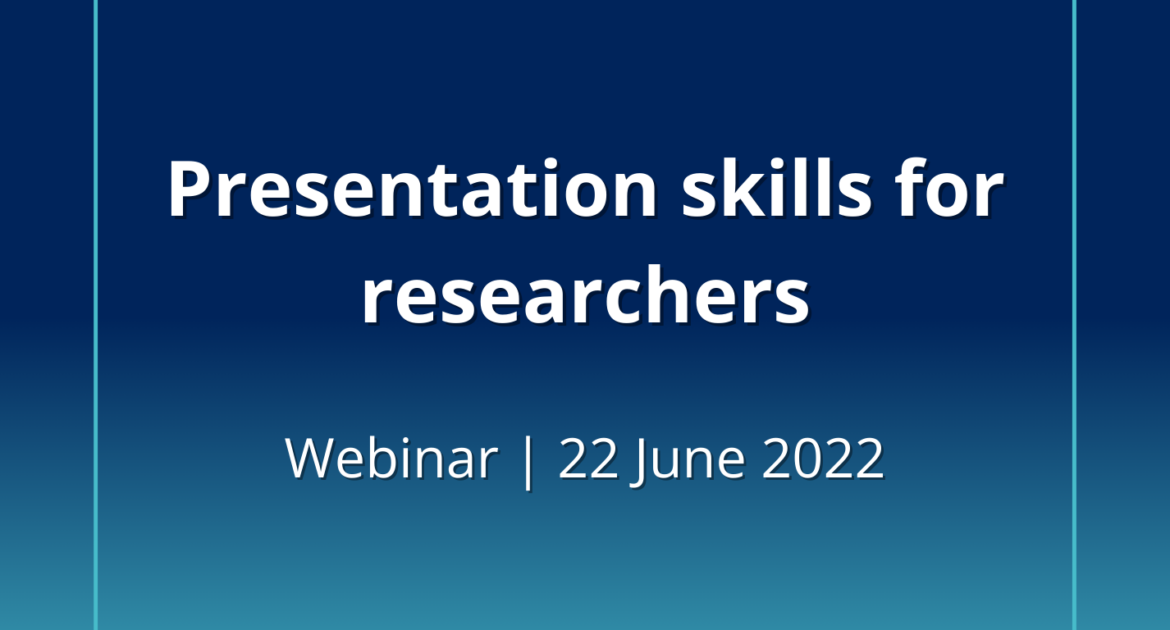Presentation Skills for Researchers
Did you attend jobs.ac.uk’s and Vitae’s live webinar on Presentation Skills for Researchers? Drawing from 10 years of experience in delivering training courses and lectures, Dr. Mhairi Towler shared her top tips for presenting and building your network in a range of face-to-face and online scenarios. Our full webinar recording is now available to watch or read on for a summary of the main points:
- What’s the story that you want to tell?
- What are your key messages?
- Do you have a call to action at the end?
- Does your story have a range of ingredients?
2. Audience
- Who is your audience?
- How do you want your audience to feel and think?
3. Confidence
- How do you overcome imposter syndrome?
- How can you use the physical body to help deal with nerves?
- Why is preparation important?
4. Different settings for presenting
- What are the different settings you might be asked to present in?
- How can you present in different settings?
- What’s the comparison between face-to-face versus online?
5. Equality, diversity and inclusivity
- Are you including everyone?
- Why should you network?
- How can you make your network work for you?
- What questions can you ask yourself to progress?
- What are some strategies for building your network?
- What future actions can you be taking?
- Job interview scenarios and tips
8. Summary
- What topic areas have been discussed?
1. Constructing a narrative
What’s the story that you want to tell?
When it comes to constructing a narrative as an academic, you’re going to have to tell your story at some point. Whether you’re trying to get funding, present at a conference, or sharing your career journey. The narrative that you create will be context specific and if you’re creating lecturer material, it may not be an actual story but rather information and facts
What are your key messages?
If you are doing a pitch to investors, you could use the rule of three to help you to get three short points across. On the other hand, if you’re presenting at a conference, you might want to think about three key points that you want your audience to takeaway
It’s important to remember that stories have a beginning, middle and end:
- Beginning: setting the scene
- Middle: where the action happens
- End: a call to action
Try some practical exercises to help your audience to take in your key messages. This could include discussing a case study or getting the audience to take a quiz to reinforce what you’ve been teaching them
Do you have a call to action at the end?
A call to action is generally what you want your audience to do as a result of attending your presentation. This could be asking them to get in touch with you on social media, to tweet about your work or to send you an e-mail
Does your story have a range of ingredients?
Great stories build relationships and make people care, so it’s a good idea to question if your story has a range of the following ingredients:
- Relatability: can your audience relate to the content?
- Can you get your audience to feel your emotion or passion?
- Novelty: what makes your research story different?
- Tension / controversy: is there any tension or controversy around the topic that you’re researching, which could be used to amplify your story?
2. Audience
Who is your audience?
You need to know who your audience is. For instance, are they experts or non-experts? Knowing who the audience is can help you to know what kind of language you should use. If it’s a general audience then you may want to remove jargon and acronyms
How do you want your audience to think and feel?
When preparing your narrative, you should always think about your audience and question how you want them to feel and what you want them to think. The audience are not tigers who want to eat you, just an audience who want to hear what you’ve got to say. Therefore, consider these questions:
- How do you build a rapport?
- How do you keep people interested?
- How do you avoid misinterpretation?
- Are there any metaphors you can use for your research?
- Is there ‘an ask’ at the end?
3. Confidence
How do you overcome imposter syndrome?
Have you ever said to yourself, “I don’t know what I’m doing here; any moment now, someone’s going to find out I’m not up to this job”? If you have, then you’re among 70% of people who suffer from imposter syndrome. It can get in the way of your confidence and result in you second guessing yourself. To overcome this, you need to remember that you’ve been asked to do this presentation for a reason. You are the expert on a topic, so you need to embrace your status as a speaker. Your voice, and what you have to say matters and it will add value to someone. You wouldn’t be doing what you’re doing if you weren’t qualified or experienced enough to do it
How can you use the physical body to help deal with nerves?
Using the physical body to control nerves and build confidence can be very effective, here we can employ some skills that actors learn at drama school to deal with nerves:
- Breathe: if you’re nervous before a talk then take some time to do some deep breaths. Breathing exercises can slow down the adrenaline and the fight or flight response that we feel when we’re on stage, either virtual or real. Even take time to do this when you’re on the stage, stand and take a moment to look around the room, make eye contact with a few people, this will also get the audience’s attention and signal to them to be quiet as you’re ready to begin, then once you’ve taken a few breaths speak on the exhale
- Voice: with the voice, you need to be intentional about the tone of voice that you use e.g., do you want to be authoritative to get your point across? You need to warm up your voice like professional singers do. Project to the back of the room if you’re on a stage, this involves breathing and holding your head up and speaking from the diaphragm. Don’t forget to have water with you as it’s not always provided
- Posture: you should try and take up as much space as you can and stand, if possible, as this helps to project your voice. When presenting online a standing desk can help with this. It’s also a good idea to uncross your legs and arms, hold your head up, ground yourself through your feet to steady yourself and use intentional gestures. Other pointers include keeping your head still, not playing with your hair or jangling coins in your pockets. A TED Talk by Amy Cuddy explains how power poses such as standing with your arms stretched out like a star shape or placing your hands on your hips like Wonder Woman for two minutes can change the level of hormones in your body, decrease stress and help you to feel more confident. Top tip: before presenting, if you can, go to the bathroom and give power posing a go to give yourself a confidence boost before going to speak
- Pace: the most important thing you can do to feel more confident is to slow down. Again, engage the use of breathing exercises, at the end of every sentence take a breath. Practice taking a breath at every punctuation mark as doing this can allow you to get rid of filler words such as “umm” and “erm”. Everyone has a natural pace of delivery, so experiment to find out what yours is
Furthermore, you can also use pauses for effect. Examples include thinking pauses, a pause to let the audience absorb what you’ve said, a check your notes pause and a pause within a talk to bring the audience’s attention back to you because they will be wondering why you’ve stopped speaking
Other methods you can try to reduce nerves include meditation, exercise to burn off any excess adrenaline, visualisation exercises, apps such as The Tapping Solution and journaling
Why is preparation important?
The key to calming nerves and delivering a good presentation is just practising! You must rehearse your presentation and if possible, practice in the room that you will present in
Practice the presentation delivery for timing, to ensure that it fits into the time slot you’ve been given. As a rule of thumb, give about one minute per slide. It’s very rude and arrogant for a talk to run over into someone else’s time slot. If you’re doing a business pitch, the panel will just cut you off if you’ve not finished, meaning your takeaway messages could be missed
Technology is another factor to think about. If you can find out what the computer setup is ahead of time, then that’s something that will put you at ease. Do you have to send slides before the presentation? Will you have to bring a USB stick with your slides on and transfer them onto the organiser’s computer? It’s a good idea to bring your own laptop with an adapter cable and power cord just in case. And will you be able to see Presenter View in PowerPoint so that if you’ve taken notes or written notes down for your slides, will you be able to see them? All these things should be thought about ahead of time
Sometimes you will be asked to wear a microphone so it might be worth preparing your outfit for this e.g., wearing an outfit that has pockets to slip the microphone box into. If you are wearing a dress, it’s also important to be aware that the microphone wire may have to feed through the bottom
If you’re using a handheld microphone, don’t hold it too close to your mouth as this will create feedback and remember you may be in charge of using a laser pointer and moving the slides forward
4. Different settings for presenting
What are the different settings you might be asked to present in?
- Face-to-face
- Virtual
- Pitching
- Teaching
- Interviewing
- Panel
How can you present in different settings?
Face-to-face:
- Build rapport: chat to people as they come into the room and try to learn their names
- Housekeeping: it’s a good idea to introduce yourself even if you’ve greeted people coming into the room, let them know that slides will be sent on, share the procedure in the event of a fire, if there’s a plan for any breaks and to turn their phones off
- Icebreakers: you might want to include an ice breaker to get people to know one another better. One idea is to ask people to sketch out their research
- Room considerations: you should consider the set-up and understand the layout. Do you need to bring any equipment with you or see if more desks or chairs are required?
- Knowing the type of setting you will be presenting in: knowing what kind of room you are in can help you know what the technology considerations are in the different settings for instance, does the audio work? Do you need a microphone? Can you dim the lights if needed? These are a few things you need to think about when you enter a new environment to present your work
Virtual
- Build rapport and make use of the chat box: as people start appearing online you can build rapport by asking questions, such as their name, a hobby or occupation, to make the audience feel valued and included
- Waterfall technique: you might want to try the waterfall technique as an ice breaker online. You can ask the audience a question such as their favourite song and to type it into the chat box so on the count of three everyone presses return so that all the answers will appear at the same time. By asking a general question, it gets people to start getting involved immediately and using the chat function
- Housekeeping: this can be making sure everyone is muted, having the cameras on or off, check if you have permission to record, how people can raise technology issues and questions, consider people might be multi-tasking, let the audience know if they will receive a copy of the slides if they haven’t already, inform them of the plan and if there will be any breaks or a chance to ask questions
Top tips to presenting online include:
- Having an extra pair of eyes: if you have two screens, open the slides on one screen and the audience on the other, then another person can monitor the chat box for you
- Remember to click the audio on: if you have any audio in your slides then it’s important to enable audio within the software you are using
- Registering for your presentation: software programmes such as Zoom and Microsoft Teams take registrations automatically but you can also take a note of who has attended in your session break
- Breakout rooms: you can make use of breakout rooms for group discussions
- Interact with participants: there are many tools out there that allow you to interact with your audience, such as Whiteboard, Padlet, Mentimeter and Slido. Incorporate these into your presentation to make it more engaging
Hybrid setup: a hybrid set-up might be more commonplace now, with organisations wanting to cut costs and there being more considerations towards the impact of travel on the environment. When it comes to a hybrid set-up this may involve:
- You’re online and participants are present in-person: this set-up is the least predictable in terms of interaction as you don’t have access to names and it’s hard to call people out to ask a question
- You’re there in-person and there is a mix of participants online and in-person: this is where you might use the Meeting Owl where the camera tracks you and follows whoever is talking in the room
What’s the comparison between face-to-face versus online?
- What is the same?
- Building rapport with people
- The slides you use will most likely be the same
- The use of people’s names
What is the different?
- Live subtitles may be on if you’re presenting online
- Taking a register in-person can be more labour intensive
- There will be a difference in the tools used
- The way everyone interacts will be different
5. Equality, diversity and inclusivity
Are you including everyone?
- You should encourage contributions from everyone, whether you’re face to face or virtual, and for everyone to respect each other when they’re discussing topics. Make sure that people are listening to one another, and make use of a safe space policy if the organisation has one
- Learn people’s names and use them to enable people to feel included
- If it’s the same person answering the questions, then encourage others to have a go. If someone is dominating in a group then you can stand over them and use body language to show they’re not the most important person in the room, this also gives other people permission to have a go
- Colour consideration is important when designing your slides as those who have visual impairments might be using screen readers and so you may have to input alternative text. You can run your slides through an accessibility tracker and Adobe Color allows you to check what colours work for people who are colour blind
- Live captions and subtitles do not always pick up on the nuances of very different accents. So, it’s a good idea to have a practice with subtitles as they can be off putting if you haven’t used live captions before or you could send a copy of the presentation with subtitles afterwards
- With cultural barriers, sometimes people lack confidence to speak especially if English isn’t their first language, so encourage them to speak and have patience when understanding what they’re saying. If you don’t know how to pronounce somebody’s name, just ask them to pronounce it and be authentic. With this, simplify your slides to consider that some people may already be reading subtitles at the same time
- Unconscious bias can crop up in many ways such as just speaking to the people who are speaking to you. Those people might be the extroverts in the room and therefore, work hard to include everybody, even the people who may be a bit quieter
- Giving the audience the choice to decide if they want their camera on or off, however, this can be dependent on the situation, and you can ask the audience to go with your preferred method
6. Building your network
Why should you network?
- It helps you to build relationships within your organisation
- You will be more likely to receive invitations to speak at conferences
- If you are thinking about changing career, it might help you get your next job
- It will help you to find partners to collaborate with in an academic setting
- Networks can provide moral support if there are any issues coming up at work
How can you make your network work for you?
- Identify your goals (professional or personal)
- Ask what information you need to progress those goals
- Who do you know that has the information you need?
- What have you got to do to get that information?
What questions can you ask yourself to progress?
- Who are the people that you would most like to meet?
- Who do you want to collaborate with?
- How can you find them?
- How can you go about promoting yourself in the academic world?
- What have you got to do to get that information?
- Map out your contacts on a big piece of paper and you’ll be surprised at the links that are already showing up and within your own network
What are some strategies for building your network?
- Promote your work on social media such as LinkedIn, Twitter, Instagram and TikTok
- If you have a website, you can put blogs, podcasts and videos on there
- Keep in touch with previous contacts. This is all about nurturing your network, you might
ask people for the virtual catch up or a coffee, generally keeping in touch with others to see how they’re getting on
- Join committees, although be careful as sometimes this can take up a lot of time
- At conferences you can usually engage with others on Twitter by using the hashtag event. You could apply to speak at a conference, present a poster or ask to give a talk at another university. Find out who’s going to the conference so you can be targeted with your networking, don’t just stick with your own group, and be sure to ask questions to get noticed and raise your profile
What future actions can you be taking?
- Even if you’re at an early stage in your PhD or at the start of a contract, you could be thinking about the next career step and what you want to do later. You can start by researching future workplaces and how you can fund them yourself or if there’s any fellowships out there that may suit your line of work
- You may even question if you want to stay in academia or move into another industry. This will require a lot of soul searching so it’s worth visualising where you want to go next and what you want your future to look like
7. Job interviews
What are some job interview scenarios and tips?
- Interviews can be conducted in different scenarios: face-to-face, virtual, assessment centre or telephone
- If you’ve been asked for an interview, it means they’re impressed by what they’ve seen on the application and that you’re qualified for the job
- If you get the option to have a face-to-face or online interview it may be best to choose a face-to-face interview because it allows for natural conversations to flow around the interview timings, but it also gives you a gut feeling for the place and the people that you’re going to be working for, which is harder to ascertain if you’re doing an interview online
- Most job interviews will request a sample lecture so your presentation skills will be assessed
- Take your time when answering questions
- Remember to breathe
8. Summary
What topic areas have been discussed?
In conclusion we have discussed topic areas such as:
- How to construct your narrative
- Who your audience is and how constructing the right story for them
- Tips to build your confidence when presenting
- Things to consider for different presentation formats
- Online versus face-to-face presentations
- How to build a successful network to get your next position
For more information on any of the topics covered in this article, please watch the full webinar recording and browse our career advice section to find more resources on managing your academic career, working abroad and gaining tips for your PhD journey.






Leave a Reply